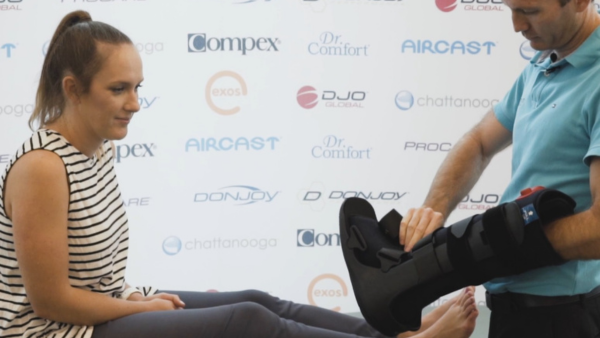Ankle injuries are a common occurrence, and they can happen to anyone at any time. Whether you’re an athlete, a busy parent, or just someone going about their daily activities, a sudden twist or impact to the ankle can leave you wondering have I broken or just sprained my ankle. Our article Ankle Fracture vs. Sprain: Know the Difference? is the perfect short and informative read to help you understand the distinction between these two conditions is crucial for proper treatment and a speedy recovery.
How Ankle Injuries are Managed at Activate Physiotherapy
At Activate Physiotherapy, we specialise in providing comprehensive fracture management for non-complicated fractures right in your community, so you don’t have to spend hours waiting in emergency departments. In this article, we’ll help you differentiate between a sprained ankle and a fractured one, offering valuable insights into symptoms, diagnosis, and the importance of seeking professional care. If you suspect you have suffered a fracture, don’t hesitate to contact our team of expert physios or make an appointment online – we’re here to help.


Understanding the Ankle
Before diving into the details of ankle injuries, let’s get acquainted with the anatomy of the ankle joint. The ankle is a complex structure composed of three bones: the tibia, the fibula, and the talus. Ligaments, tendons, and muscles work together to provide stability and mobility to this vital joint. The way these elements interact allows for flexion, extension, and side-to-side motion – essential for activities like walking, running, and jumping.
What Causes Ankle Injuries?
Ankle injuries can occur due to a variety of reasons, including:
Sports Injuries:
Athletes are prone to ankle injuries, particularly when they participate in activities that require rapid changes in direction, such as soccer, basketball, and tennis.
Accidental Falls:
Slips, trips, and falls are common causes of ankle injuries, whether it’s on a slippery surface or uneven footpaths.
Overuse:
Continuous stress on the ankle joint, often seen in long-distance runners or individuals on their feet for extended periods, can lead to injury.
Repetitive Motions:
Activities that involve repetitive ankle motions, like dancing or cycling, can also result in injuries over time.

Common Symptoms of Ankle Injuries
Regardless of whether your ankle injury is a sprain or a fracture, there are some common symptoms to look out for:
- Pain and discomfort
- Swelling and bruising
- Difficulty bearing weight on the affected ankle
- Limited range of motion
- Instability or feeling like the ankle is “giving way”
- A popping or snapping sound at the time of injury
Ankle Fracture vs. Sprain: How to Know the Difference
It can be challenging to distinguish between a sprained ankle and a fractured one, as the symptoms can overlap. However, understanding the key differences is crucial for effective treatment:
Sprained Ankle
A sprained ankle occurs when the ligaments that support the ankle joint are stretched or torn. It is usually less severe than a fracture and may involve the following characteristics:
- Mild to moderate pain
- Swelling that develops gradually
- Bruising that may not be immediate
- Tenderness around the injured area
- Typically, you can bear some weight on a sprained ankle, although it might be painful.
Fractured Ankle
A fractured ankle involves a break in one or more of the ankle bones (tibia, fibula, or talus) and is generally more severe than a sprain. Signs of a fractured ankle may include:
- Intense pain, often sharp or throbbing
- Immediate swelling and noticeable deformity
- Rapid development of bruising
- Extreme tenderness to the touch
- Difficulty or inability to bear weight on the affected ankle
If you suspect you have a fractured ankle, it’s crucial to seek treatment promptly. That being said our team have seen some pretty nasty sprains, so a proper evaluation by a physiotherapist is advisable in either circumstance to ensure proper healing.

Diagnosing Ankle Injuries
To determine the extent of your ankle injury and whether it’s a sprain or a fracture, you should seek professional evaluation. However, it isn’t essential for you to present to the hospital emergency department. At Activate Physiotherapy, our experienced physiotherapists are skilled in assessing ankle injuries. We employ various diagnostic techniques, including:
Clinical assessment:
This involves evaluating your symptoms, conducting physical tests, and discussing the circumstances of the injury.
Imaging:
X-rays, MRIs, or CT scans may be ordered to visualize the bones and soft tissues, confirming the diagnosis and helping determine the appropriate treatment plan.
The Importance of Seeking Professional Care
Whether your ankle injury is a sprain or a fracture, seeking professional care is crucial for several reasons:
Accurate diagnosis:
Only a trained healthcare provider can accurately differentiate between a sprain and a fracture. This ensures you receive the right treatment.
Preventing complications:
Untreated or improperly treated fractures can lead to long-term issues such as chronic pain, arthritis, or instability. Professional care minimizes these risks.
Customised treatment:
Our expert physiotherapists can create a personalised treatment plan tailored to your specific injury, helping you recover faster and more effectively.
Rehabilitation and prevention:
Physiotherapy not only aids in your recovery but also focuses on strengthening the ankle to prevent future injuries.

Ankle Fracture vs. Sprain: Know the Difference for Treatment Options
The treatment for a sprained ankle and a fractured ankle can vary significantly. Here’s an overview of what you can expect:
For a Sprained Ankle:
Rest: Appropriate rest in the very early stages of an ankle sprain allows the ligaments to heal by minimising excessive stresses and strains.
Ice: Applying ice can reduce swelling and relieve pain.
Compression: Wrapping the ankle with a bandage or brace can provide support and reduce swelling.
Elevation: Keeping the ankle elevated above heart level can help reduce swelling.
Movement and Loading: Whilst rest in the initial couple of days after a sprain is usually recommended, resting for too long can delay your recovery. Research and our experience tells us that people who get going earlier with appropriate movement and loading recover quicker and have less secondary issues following their ankle sprain.
Physiotherapy: Our expert physiotherapists will design a rehabilitation program to strengthen the ankle and improve its stability. We are in it to help you heal but also get back to what you want and need to do quickly, safely and effectively and keep you there!
For a Fractured Ankle:
Immobilisation: A moonboot or cast is often required to keep the fractured bones in place and promote healing.
Physiotherapy: It might surprise you to know that even fractured bones benefit from loading. Appropriate loading as guided by your physiotherapist can aid in bone healing helping you to recover faster and stronger. Post-moonboot removal or post-surgery, physiotherapy is essential to regain strength, mobility, and function in the ankle.
Long-term monitoring: Fractured ankles may require ongoing care to ensure optimal healing and prevent complications. It is also highly recommended for people looking to re-enage in sports and high-level activity.
Surgery: In some cases, surgery may be necessary to realign and stabilise the fractured bones. Our team work closely with Brisbane’s best orthopaedic surgeons to determine if your injury requires operative management.
Preventing Ankle Injuries
Prevention is always better than cure. To reduce the risk of ankle injuries, consider the following measures:
- Warm-up and stretching: Prior to physical activity, engage in proper warm-up exercises and stretch your ankle muscles and ligaments.
- Wear appropriate footwear: Choose footwear that provides adequate support and cushioning for your specific activities.
- Strengthening exercises: Incorporate exercises that target ankle stability and strength into your fitness routine.
- Be cautious on uneven surfaces: Pay attention to your surroundings and watch out for hazards that could cause a fall.
- Seek professional guidance: If you’re prone to ankle injuries or have had one before, it’s true you are more likely to suffer one again. If this is you, consult a physiotherapist for guidance on injury prevention.
- Strapping and Bracing: If you’re returning to sport or high level activity ongoing strapping or ankle bracing can help you get back on the court or field faster and avoid reinjury while you are still working on getting your ankle back to where it needs to be.
In summary, differentiating between a sprained ankle and a fractured ankle can be challenging due to overlapping symptoms. Regardless of the nature of your ankle injury, it’s essential to seek professional care to receive an accurate diagnosis and appropriate treatment. At Activate Physiotherapy, our team of expert physiotherapists is here to help you on your road to recovery. If you suspect you have suffered an ankle fracture or have any concerns about your ankle health, don’t hesitate to contact us.
Contact Activate Physiotherapy
Our team of knowledgeable and friendly physiotherapists is dedicated to providing you with the best care possible. If you believe you may have a fractured or sprained your ankle ankle or are experiencing any ankle-related concerns, please don’t hesitate to get in touch. You can contact us by phone, email, or make an appointment online through our user-friendly portal. We look forward to helping you on your journey to recovery and optimal ankle health.
Want to know more?
Why not have a chat with one of our expert Physios by calling your nearest clinic or enquiring online? A physio will speak to you about your options and provide all the information specific to your injury – obligation-free.
To make a booking click on your nearest clinic: Tingalpa or Stafford.


Recent Comments